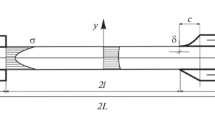Abstract
Single-grit grinding of a 2.5D woven composite was investigated by the finite-element method (FEM) using a unit-cell model. According to our hypotheses, the axis of the warp yarn was a sinusoidal curve and the cross section of the weft yarn was shaped like a biconvex lens. AVUMAT subroutine was used to construct the constitutive model of the 2.5D woven composite. The grinding process of the composite was analyzed using an FEM simulation with the ABAQUS/Explicit software. A validation experiment was also carried out. The simulation results showed that a grinding crack was well simulated. Furthermore, the junctions between the warp yarn and weft yarn were found to be seriously damaged and cracks were observed to extend outward along the warp fiber during grinding, in good agreement with the experimental results. In addition, the strain of weft yarns was obviously greater than that of warp yarns when the grinding direction was perpendicular to the weft yarns and parallel to the axis of the warp yarns. These results demonstrate that the mesostructure strongly influences the grinding damage inflicted on woven composites.








Similar content being viewed by others
References
Li ZJ, Sun BZ, Gu BH (2010) FEM simulation of 3D angle-interlock woven composite under ballistic impact from unit cell approach. Comput Mater Sci 49(1):171–183
Camanho PP, Davila CG, De Moura MF (2003) Numerical simulation of mixed-mode progressive delamination in composite materials. J Compos Mater 37(16):1415–1438
Ji KH, Kim SJ (2007) Dynamic direct numerical simulation of woven composites for low-velocity impact. J Compos Mater 41(2):175–200
Zhou J, Guan Z, Cantwell W (2014) Numerical modelling of perforation impact damage of fibre metal laminates. In: International Conference on Computational Methods (ICCM2014). Scientech Publisher, Cambridge, UK
Mahadik Y, Hallett SR (2010) Finite element modelling of tow geometry in 3D woven fabrics. Compos A Appl Sci Manuf 41(9):1192–1200
Sun CT, Vaidya RS (1996) Prediction of composite properties from a representative volume element. Compos Sci Technol 56(2):171–179
Boey YK, Kwon YW (2013) Progressive damage and failure strength of notched woven fabric composites under axial loading with varying strain rates. Compos Struct 96:824–832
Hallal A, Younes R, Fardoun F et al (2012) Improved analytical model to predict the effective elastic properties of 2.5D interlock woven fabrics composite. Compos Struct 94(10):3009–3028
Brinksmeier E, Aurich JC, Govekar E et al (2006) Advances in modeling and simulation of grinding processes. Ann CIRP 55(2):667–696
Ohbuchi Y, Obikawa T (2003) Finite element modeling of chip formation in the domain of negative rake angle cutting. transactions of the ASME. J Eng Mater Technol 125(3):324–332
Qing H, Mishnaevsky L (2009) Unidirectional high fiber content composites: automatic 3D FE model generation and damage simulation. Comput Mater Sci 47(2):548–555
Klocke F, Beck T, Hoppe S et al (2002) Examples of FEM application in manufacturing technology. J Mater Process Technol 120(1–3):450–457
Zhang B, Peng X (2000) Grinding damage prediction for ceramic via CDM model. J Manuf Sci Eng 122(1):51–58
Cao XY, Lin B, Zhang XF (2013) A study on grinding surface waviness of woven ceramic matrix composites. Appl Surf Sci 270:503–512
Shi DQ, Jing X, Yang XG (2014) Numerical prediction of tensile properties and damage evolution of three dimensional-four directional braided CMCs. Acta Mater Compos Sinica 31(6):1543–1550 (in Chinese)
Chamis CC (1989) Mechanics of composite materials: past, present, and future. J Compos Technol Res 11(1):3–14
Chamis CC (1984) Simplified composite micromechanics equations for strength, fracture toughness and environmental effects. In: Technical Sessions of the Thirty-Ninth Annual Conference—Reinforced Plastics/Composites Institute. New York, USA
Acknowledgements
This study was supported by the National Natural Science Foundation of China (No. 51305296).
Author information
Authors and Affiliations
Corresponding author
Rights and permissions
About this article
Cite this article
Wang, Y., Ding, C. & Lin, B. FEM Simulation of Single-Grit Grinding on a 2.5D Woven Composite. Trans. Tianjin Univ. 23, 538–546 (2017). https://doi.org/10.1007/s12209-017-0083-9
Received:
Revised:
Accepted:
Published:
Issue Date:
DOI: https://doi.org/10.1007/s12209-017-0083-9




